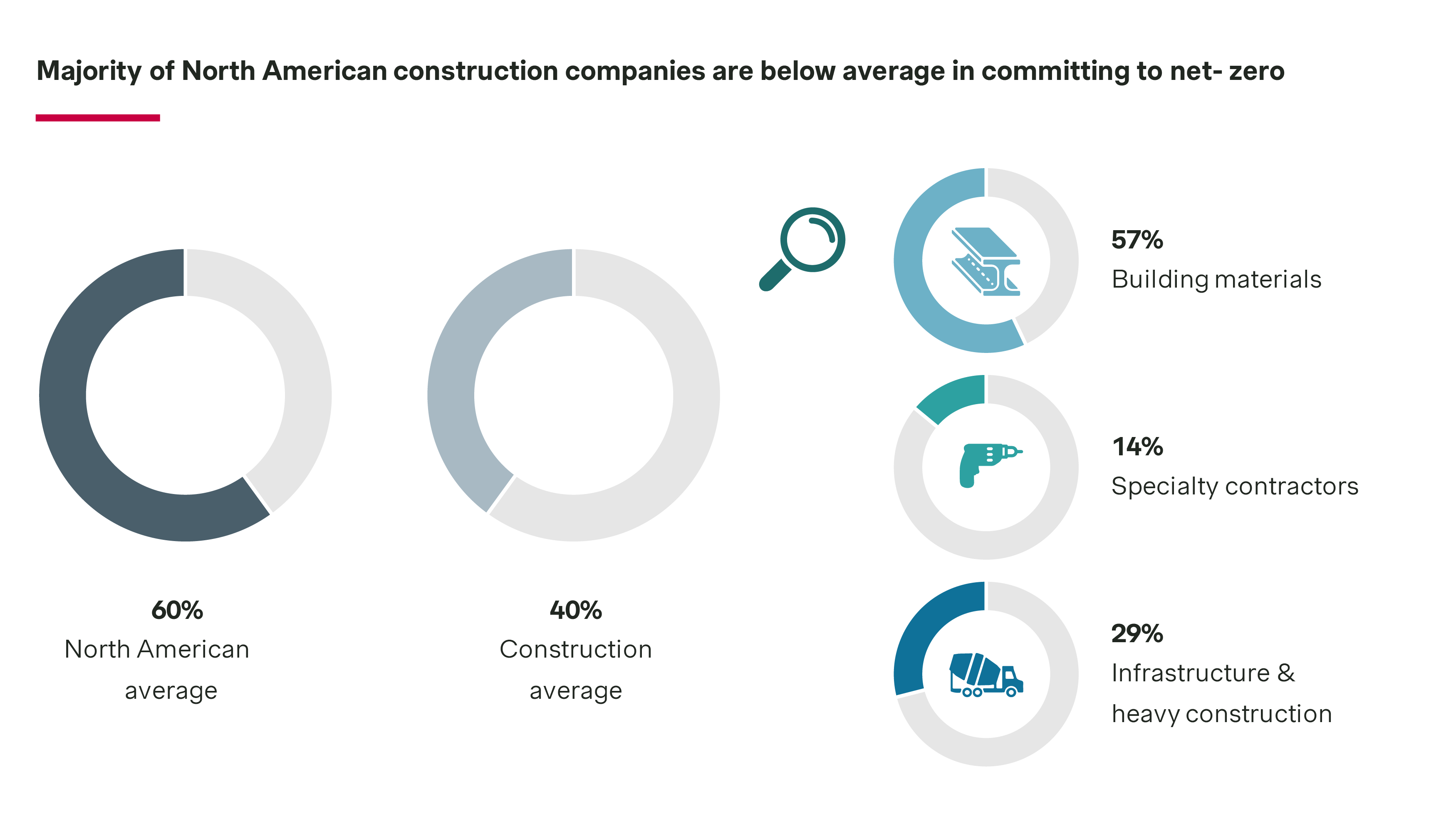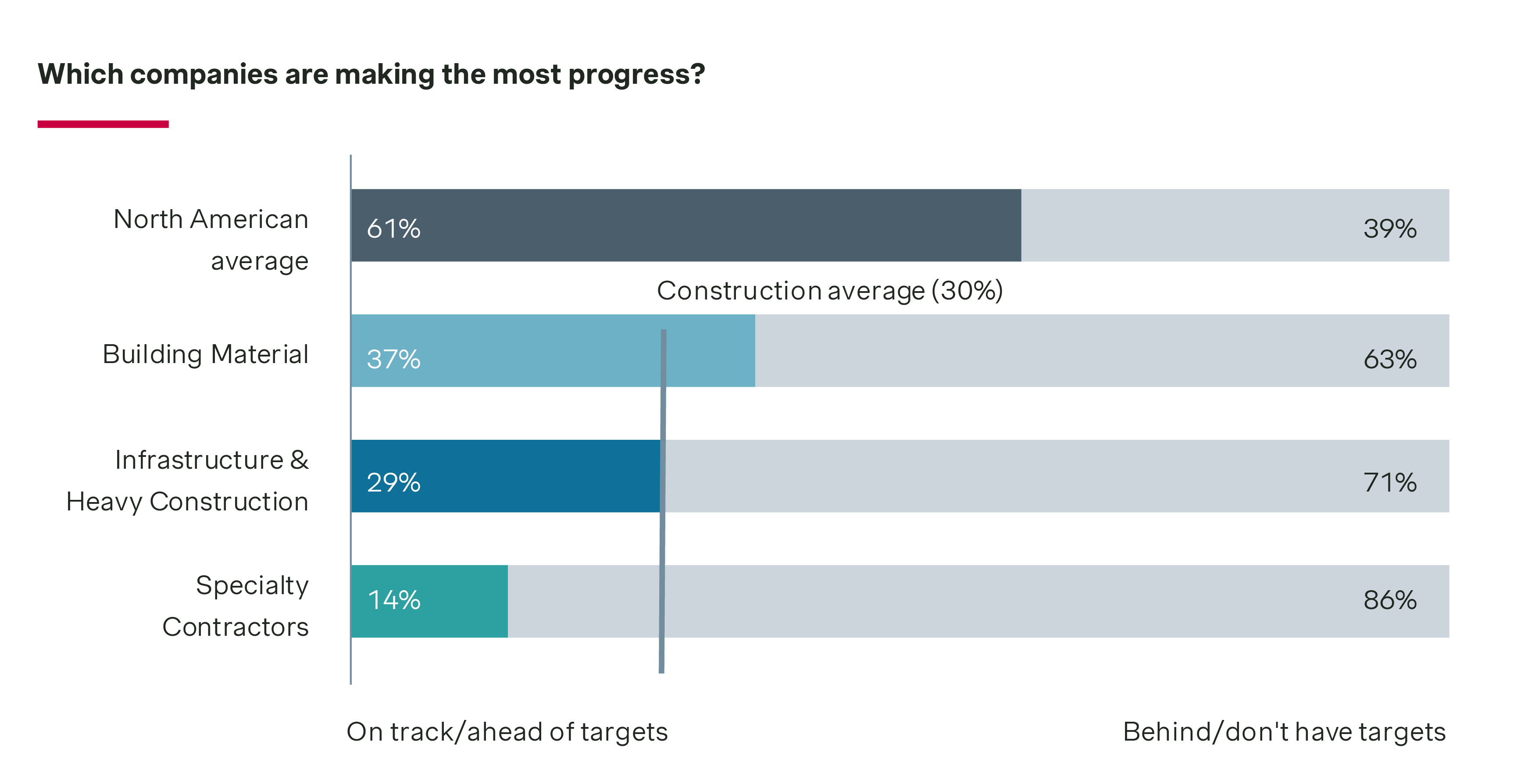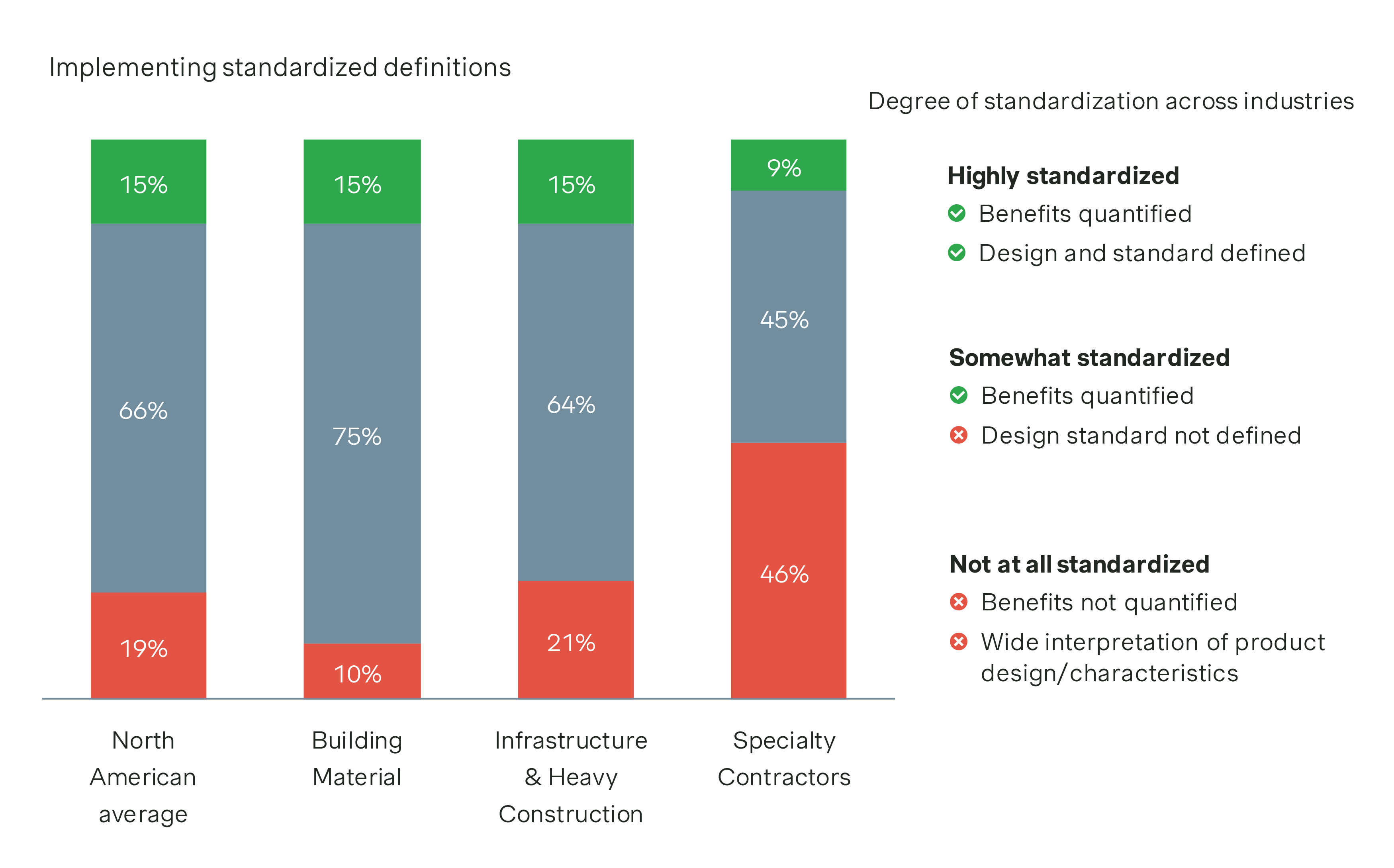Form placeholder. This will only show within the editor
Sustainability has emerged as a crucial focal point for construction companies to meet environmental goals and drive profitability. Our recent B2B sustainability study reveals how the construction industry in North America is grappling with this imperative.
Despite a growing commitment to green initiatives, the construction sector lags behind other industries in North America. Our study uncovers the contrast between ambition and reality, shedding light on both achievements and ongoing challenges.
As our study reveals, customer demand and the drive for market share are still the main motivators for sustainability. However, the journey toward these goals is anything but straightforward. High costs, substantial investments, and finding the right partners are just a few of the hurdles faced. Plus, the concept of what qualifies as “green” remains frustratingly vague for many in the industry.
Yet, there is a silver lining. Certain companies are paving the way with impressive green revenue, while others are poised to follow suit, capitalizing on proven strategies. How does your company compare? Are you a leader, a fast-follower, or still finding your footing?
In this article, we explore the steps necessary to overcome these barriers and achieve profitable green growth in construction.
Understanding the sustainability commitment
Why do some construction companies soar in their sustainability commitments, while others seem to tread water? In North America, a promising 40% of construction entities have set their sights on net-zero targets by 2030. Yet, pause for a moment – this figure falls short of the broader North American ambition of 60%. What gives?

Digging deeper, we notice a shift in focus. Traditionally, Scope 1 emissions garnered most attention. But now, 25% of industry players are pivoting toward Scope 3 emission management.
What drives this push? Unsurprisingly, customer demand and the hunt for a larger market share remain at the forefront. To keep pace with downstream buyers’ demand for sustainable products, producers need to prioritize sustainable solutions that can be developed and brought to market profitably and effectively.
Aligning with market sentiment isn't just good practice; it's essential for those aiming to lead the pack in sustainability. Major downstream buyers like Home Depot and Lowe's are already prioritizing sustainability, making it crucial for construction players to do the same to prevent market share erosion.
Yet, one might wonder, with such compelling reasons to act, why isn't every company on board? The reasons are nuanced, but the message is clear. Embracing sustainability is not just about setting goals; it's about defining what green growth means for you. It's about turning challenges into opportunities, and uncertainties into certainties.
Overcoming barriers to achieve sustainability targets
Why do some companies in the construction sector struggle to reach their sustainability goals? Only a small fraction are on track, with just 30% of construction companies meeting or exceeding their targets.

The answer lies in understanding the obstacles that stand in their way. High costs of green solutions, significant investment requirements, and the challenge of finding suitable partners loom large. Each of these barriers can feel insurmountable. Yet, they offer an opportunity for growth and innovation.
How to transform these obstacles into steppingstones toward success?
- Clarify what “green” means within your organization. This involves setting clear, achievable standards and expectations for what sustainability looks like in your operations.
- Tackling the high costs associated with green solutions demands creativity and a willingness to invest in the future. Don't just spend money on sustainability for the sake of it. Strategically invest in a sustainable future for your company and the planet.
- Finding the right partners requires a commitment to collaboration. Collaborative partnerships can pool resources, share expertise, and drive innovation, making sustainable solutions more accessible and effective.
Embracing these challenges is the first step toward not just achieving sustainability targets but exceeding them. With each barrier overcome, your company moves closer to leading the charge in the construction industry's green revolution.
Demystifying “green” in construction
What does “green” really mean for businesses in the construction industry? The answer is more complex than you might think. Our study reveals a significant variance in the degree of standardization for "green" practices.

Overall, only 15% of companies in North America have highly standardized their sustainability efforts, clearly defining and quantifying benefits and designs. A majority, 66%, report somewhat standardized practices, where benefits are quantified but design standards are not fully defined. Notably, 19% of companies lack any standardization, leading to wide interpretations of product design and characteristics.
Among sectors, building materials show the highest level of somewhat standardized practices at 75%. Specialty contractors lag behind, with 46% reporting no standardization at all. This disparity underscores the need for clearer, more consistent standards to drive meaningful sustainability progress across the industry.
The maturity spectrum: leaders vs. followers
The construction sector in North America remains largely traditional, with many companies making less than 20% of their revenue from green solutions. However, green revenue leaders are proving the profit potential of sustainable practices. These companies are not only meeting their sustainability targets but also leveraging green solutions to drive commercial success.

In North America, the construction industry sees a clear division: 22% are sustainability leaders, while 78% are followers. Leaders focus on green revenue growth by:
- Setting industry standards: Sustainability leaders are 1.6 times more likely to focus on shaping industry-level green standards to secure future green revenue streams.
- Building regulatory support: They are 1.5 times more likely to address the lack of regulatory bodies providing security for their investment decisions.
- Capital access: Leaders are 1.3 times more likely to push for access to capital finance, such as green or ESG-linked bonds.
On the other hand, sustainability followers aim to protect market share by focusing on identifying the right products, unlocking R&D budgets, and reducing green price premiums.
- Lack of market insight: Followers are 2.1 times more likely to flag a lack of market insight on the best solutions for their sustainability goals.
- Lower R&D budgets: They are 1.6 times more likely to have minimal R&D budgets available for green solution development.
- Fewer green price premiums: Followers are 1.2 times more likely to refuse high prices for green solutions, ruling out “buy it” as a commercialization strategy.
By understanding these contrasting paths, companies can better position themselves on the spectrum of sustainability maturity, leveraging insights from leaders to drive their own green growth.
Three questions to map your green growth strategy
On the path to decarbonization and responsible corporate sustainability, it’s critical to prioritize initiatives and invest in relevant expertise and resources. Our proven framework, based on these fundamental questions, can help B2B companies assess their readiness for net-zero targets and commercialization.
When?
Evaluate market demand to determine the best time to introduce sustainable solutions.
- Analyze growth drivers and trends
- Identify green buying factors
- Project future green demand
- Quantify green premiums
- Prioritize attractive profit pools
Where?
Identify USP to maximize competitive advantage with target customers.
- Identify and map green playing fields
- Assess capability and competitiveness
- Develop best-fit value propositions
- Scale up ecosystems
- Assess risks and mitigation options
How?
Develop and execute a robust go-to-market strategy
- Prioritize target segments
- Decide on sales operating model
- Outline contract/price model
- Develop value story
- Plan baseload and ramp-up
At Simon-Kucher, we provide valuable assistance to address your sustainability challenges. Through strategic pricing and marketing initiatives, we help you seize opportunities and gain a competitive advantage in the market. Reach out to Simon-Kucher to differentiate your business in the market and drive growth through sustainable practices.








